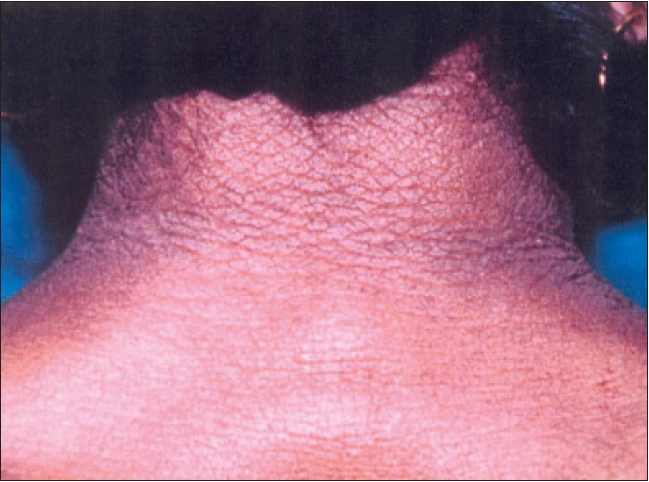Translate this page into:
Acanthosis nigricans in an HIV seropositive: Is there a correlation?
Correspondence Address:
Y S Marfatia
101, Nandanvan society, 2, Yogidhara flats, Alkapuri, Vadodara - 390 007
India
| How to cite this article: Marfatia Y S, Sharma A. Acanthosis nigricans in an HIV seropositive: Is there a correlation?. Indian J Dermatol Venereol Leprol 2006;72:383-384 |
 |
| HIV positive female with acanthosis nigricans |
 |
| HIV positive female with acanthosis nigricans |
Sir,
Acanthosis nigricans is a cutaneous disorder of hyperpigmentation and papillomatosis that may precede or coincide with a variety of benign, familial or malignant disorders. Acanthosis nigricans is characterized by hyperkeratosis and pigmentation and the affected skin is covered by papillomatous elevations, which gives it a velvety texture.[1] The etiopathogenesis of acanthosis nigricans is diverse and includes endocrinal as well as metabolic abnormalities. It can also be drug-induced and related to malignancy.[2] HIV / AIDS is associated with many alterations in endocrinal function. A wide range of cutaneous manifestations is reported in AIDS cases but there is a dearth of reports of acanthosis nigricans in AIDS cases. A 40-year-old nonobese female presented with complaints of fever, diarrhea, weight loss and dysphagia off and on since one year and dark skin lesions over the nape of the neck of similar duration. She had a history of blood transfusion eight years back. She was tested HIV positive by ELISA on two occasions. Due to resource constraints, CD4 count and viral load estimation were not carried out. Presence of oroesophageal candidiasis was suggestive of AIDS. Examination of the nape of the neck showed hyperpigmentation and velvety thickening of the skin, which was suggestive of acanthosis nigricans [Figure - 1]. No similar changes were observed in flexural areas.
Personal and family history was not suggestive of diabetes mellitus, thyroid dysfunction and tuberculosis. There was no family history of skin changes suggestive of acanthosis nigricans. Patient was not on any medication like nicotinic acid, fusidic acid, oral contraceptives, or triazinate, which are known to cause acanthosis nigricans.[1]
Investigations to rule out endocrinopathy and malignancy were carried out. Blood sugar, lipid profile, thyroid profile and occult blood in stool were normal. X-ray chest and USG abdomen also did not show any abnormality. PAP smear for cervical cytology was normal. Histopathological examination revealed hyperkeratosis and irregular papillomatosis, which was suggestive of acanthosis nigricans. The patient was offered opportunistic infection management as and when required but antiretroviral therapy could not be started due to inadequate resources. Any severe and chronic illness can change the rate of hormone secretion / clearance or both, even in the absence of pathological involvement of the organ concerned. Maltez et al . reported a case of AIDS who presented with three opportunistic infections (esophageal candidiasis, tuberculosis and atypical mycobacteriosis) with acanthosis nigricans. They suggested that acanthosis nigricans with AIDS behaves like a paraneoplastic syndrome.[3] Another AIDS case has been described by Mellor-Pita et al ., in which the patient developed insulin resistance, diabetes mellitus and acanthosis nigricans after treatment with protease inhibitors.[4] Endocrinal / metabolic alteration in AIDS can be a direct consequence of opportunistic infections, malignancy or therapy.[5] It is enigmatic whether the acanthosis nigricans in this case was related to underlying HIV infection or was a chance finding.
| 1. |
Judge MR, McLean WH, Munro CS. Disorders of keratinization. Rooks Textbook of Dermatology (Vol. II). Tony Burns, Stephen Breathnach, NeilCox and C. Griffiths, editors, 7th ed. Blackwell Publishing: Oxford, UK; 2004. p. 34.1-34.111.
[Google Scholar]
|
| 2. |
Houpt KR, Cruz PD. Acanthosis nigricans. Fitzpatricks Dermatology in General Medicine (Vol. II). Freedberg, Eisen, Wolff, Austen, Goldsmith, Katz. 6th ed. McGraw Hill: Newyork, USA; 2003. p. 1796-800.
[Google Scholar]
|
| 3. |
Maltez F, Martins T, Morgando A, Proenca R. Will Acanthosis nigricans be a new cutaneous manifestation of human immunodeficiency virus infection? Acta Med Port 1997;10:493-5.
[Google Scholar]
|
| 4. |
Mellor-Pita S, Yebra-Bango M, Alfaro-Martinez J, Suarez E. Acanthosis nigricans: A new manifestation of insulin resistance in patients receiving treatment with protease inhibitors. Clin Infect Dis 2002;34:716-7.
[Google Scholar]
|
| 5. |
Sellmeyer DE, Gunfeld C, Schambelan M. Endocrine abnormalities associated with HIV infection and AIDS. Textbook of AIDS Medicine, Merigan / Bartlett / Bolognesi, 2nd ed. William and Wilkins: Baltimore, USA; 1999. p. 629-39.
[Google Scholar]
|
Fulltext Views
2,685
PDF downloads
1,116





